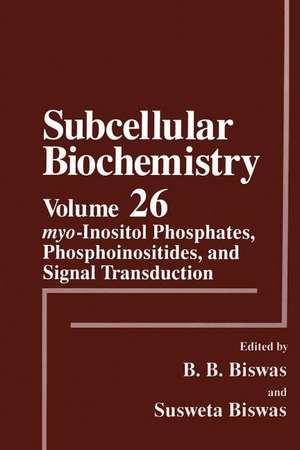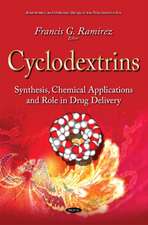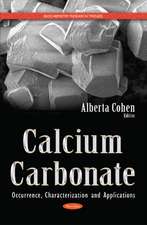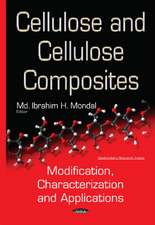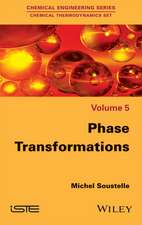myo-Inositol Phosphates, Phosphoinositides, and Signal Transduction: Subcellular Biochemistry, cartea 26
Editat de B.B. Biswas, Susweta Biswasen Limba Engleză Paperback – 28 sep 2011
Din seria Subcellular Biochemistry
- 18%
 Preț: 948.79 lei
Preț: 948.79 lei - 5%
 Preț: 1456.88 lei
Preț: 1456.88 lei - 18%
 Preț: 1373.84 lei
Preț: 1373.84 lei - 18%
 Preț: 1243.78 lei
Preț: 1243.78 lei - 18%
 Preț: 2098.81 lei
Preț: 2098.81 lei - 18%
 Preț: 1122.10 lei
Preț: 1122.10 lei - 5%
 Preț: 1160.63 lei
Preț: 1160.63 lei - 18%
 Preț: 1396.26 lei
Preț: 1396.26 lei - 18%
 Preț: 1114.96 lei
Preț: 1114.96 lei - 18%
 Preț: 1224.68 lei
Preț: 1224.68 lei - 18%
 Preț: 951.29 lei
Preț: 951.29 lei - 18%
 Preț: 1227.99 lei
Preț: 1227.99 lei -
 Preț: 398.15 lei
Preț: 398.15 lei -
 Preț: 399.88 lei
Preț: 399.88 lei - 18%
 Preț: 1231.47 lei
Preț: 1231.47 lei - 18%
 Preț: 1230.35 lei
Preț: 1230.35 lei -
 Preț: 392.60 lei
Preț: 392.60 lei - 18%
 Preț: 1231.47 lei
Preț: 1231.47 lei - 15%
 Preț: 638.76 lei
Preț: 638.76 lei - 5%
 Preț: 656.26 lei
Preț: 656.26 lei -
 Preț: 389.49 lei
Preț: 389.49 lei - 5%
 Preț: 659.19 lei
Preț: 659.19 lei -
 Preț: 392.37 lei
Preț: 392.37 lei - 5%
 Preț: 662.09 lei
Preț: 662.09 lei -
 Preț: 395.09 lei
Preț: 395.09 lei - 5%
 Preț: 667.99 lei
Preț: 667.99 lei -
 Preț: 400.47 lei
Preț: 400.47 lei - 18%
 Preț: 1224.54 lei
Preț: 1224.54 lei - 15%
 Preț: 647.73 lei
Preț: 647.73 lei - 5%
 Preț: 662.30 lei
Preț: 662.30 lei -
 Preț: 395.25 lei
Preț: 395.25 lei - 18%
 Preț: 1230.21 lei
Preț: 1230.21 lei - 18%
 Preț: 1231.95 lei
Preț: 1231.95 lei - 18%
 Preț: 964.54 lei
Preț: 964.54 lei
Preț: 646.75 lei
Preț vechi: 760.88 lei
-15% Nou
Puncte Express: 970
Preț estimativ în valută:
123.79€ • 134.51$ • 104.05£
123.79€ • 134.51$ • 104.05£
Carte tipărită la comandă
Livrare economică 21 aprilie-05 mai
Preluare comenzi: 021 569.72.76
Specificații
ISBN-13: 9781461380078
ISBN-10: 1461380073
Pagini: 448
Ilustrații: 413 p.
Dimensiuni: 152 x 229 x 24 mm
Greutate: 0.59 kg
Ediția:Softcover reprint of the original 1st ed. 1996
Editura: Springer Us
Colecția Springer
Seria Subcellular Biochemistry
Locul publicării:New York, NY, United States
ISBN-10: 1461380073
Pagini: 448
Ilustrații: 413 p.
Dimensiuni: 152 x 229 x 24 mm
Greutate: 0.59 kg
Ediția:Softcover reprint of the original 1st ed. 1996
Editura: Springer Us
Colecția Springer
Seria Subcellular Biochemistry
Locul publicării:New York, NY, United States
Public țintă
ResearchCuprins
1 History of Phosphoinositide Research.- 1. Historical Background.- 2. Modern Era.- 3. References.- 2 Phosphoinositides and Synaptic Transmission.- 1. The Brain Phosphoinositides.- 2. Further Metabolism of Inositol Trisphosphate.- 3. Phosphoinositide-Specific Phospholipase C.- 4. G Proteins and Phosphoinositide-Linked Receptors.- 5. Phosphoinositide-Linked Receptors in Nervous Tissue.- 6. The Inositol Trisphosphate Receptor and Calcium Release.- 7. Inositol-1,3,4,5-Tetrakisphosphate.- 8. Lithium Salts.- 9. Protein Kinase C.- 10. Neuromodulation and Plasticity.- 11. Phosphatidylinositol 3-Kinase.- 12. Phosphatidylinositol Glycans.- 13. The Future.- 14. References.- 3 Control of the Ca2+ Release Induced by myo-Inositol Trisphosphate and the Implication in Signal Transduction.- 1. Introduction.- 2. Functional Regulation.- 3. Heterogeneity of InsP3R.- 4. Partial Ca2+ Release in Response to Submaximal InsP3R Stimulation.- 5. Conclusions.- 6. References.- 4 Regulation of the Actin Cytoskeleton by Inositol Phospholipid Pathways.- 1. Introduction.- 2. Effect of Membranes on Actin and Satellite Proteins.- 3. ras and the Cytoskeleton.- 4. Phospholipase A2 and Arachidonate Metabolism.- 5. Phospholipase C and the Cytoskeletal Response.- 6. Phospholipid Kinases and Cytoskeletal Reorganization.- 7. Effects of Other Phospholipids on the Actin Structure.- 8. Conclusions.- 9. References.- 5 Protein Phosphorylation and Signal Transduction.- 1. Introduction.- 2. Primary Signal Transduction Mechanisms in Eukaryotes.- 3. Signal Transduction Systems in Prokaryotes.- 4. Malfunction and Disease.- 5. Future Directions.- 6. References.- 6 Structural and Functional Roles of Glycosylphosphoinositides.- 1. Introduction.- 2. Structure and Distribution of GPI Molecules.- 3. Biosynthesis and Attachment of GPI.- 4. Glycosylphosphatidylinositol in Insulin Action.- 5. Functional Roles of GPI Anchors.- 6. Conclusions.- 7. References.- 7 Inositol Pentakis- and Hexakisphosphate Metabolism Adds Versatility to the Actions of Inositol Polyphosphates: Novel Effects on Ion Channels and Protein Traffic.- 1. Introduction.- 2. Synthesis of Ins(1,3,4,5,6)P5.- 3. Ins(3,4,5,6)P4 and Ins(1,4,5,6)P4.- 4. Metabolism and Functions of InsP6.- 5. Concluding Statement.- 6. References.- 8 Inositol Phosphates and Their Metabolism in Plant.- 1. Introduction.- 2. Nomenclature of myo-Inositol and Its Phosphates.- 3. Central Role of myo-Inositol in Plant Metabolism.- 4. Metabolism of myo-Inositol Phosphates.- 5. Synthetic Analogues of Inositol Phosphates.- 6. Inositol Pyrophosphates.- 7. Metabolic Processes Involving Inositol Phosphates.- 8. Conclusions.- 9. References.- 9 Genetics of myo-Inositol Phosphate Synthesis and Accumulation.- 1. Introduction.- 2. myo-inositol and L-myo-Inositol 1-Phosphate: Synthesis/Regulation.- 3. Phosphatidylinositol Synthesis and Transport.- 4. Phosphatidylinositol Kinases and Phosphate Kinases.- 5. Phosphatidylinositol-Specific Phospholipase C and 1, 2-Cyclic Inositol Phosphates.- 6. Inositol Phosphate Receptors and Kinases.- 7. Inositol Polyphosphate Phosphatases other than Phytases.- 8. Phytases.- 9. Phytic Acid.- 10. Summary: Current Status of Inositol and Phosphatidylinositol Phosphate Genetics.- 11. References.- 10 Metabolism of myo-Inositol Phosphates and the Alternative Pathway in Generation of myo-Inositol Trisphosphate Involved in Calcium Mobilization in Plants.- Metabolism of Inositol Phosphates in Plants.- 3. Calcium Mobilization and Its Role in Plant Responses.- 4. Phosphoinositides in Plants.- 5. Phosphoinositide and Other myo-Inositol Phosphate Signaling Systems in Plants.- 6. Signaling in Plants by Wounding.- 7. Signaling in Leaf Movement.- 8. Concluding Remarks.- 9. References.- 11 Phosphoinositide Turnover and Its Role in Plant Signal Transduction.- 1. Introduction.- 2. Stress Responses in Unicellular Green Algae.- 3. Pathogen Responses in Higher Plants.- 4. Plant Movements Mediated by Osmotic Changes.- 5. Future Prospects.- 6. References.- 12 Light-Induced Signal Transduction Pathway Involving Inositol Phosphates.- 1. Introduction.- 2. Inositol Phospholipid Turnover as Signal Tranduction in Plants.- 3. Light-Stimulated Inositol Turnover.- 4. Relationship between Inositol Phospholipid Turnover and Physiological Responses.- 5. Alternate Roles for Inositol Phospholipids in Signal Transduction.- 6. Conclusions.- 7. References.- 13 Synthesis, Separation, and Identification of Different Inositol Phosphate.- 1. Introduction.- 2. Synthetic Inositol Phosphates.- 3. Separation.- 4. Identification.- 5. References.
